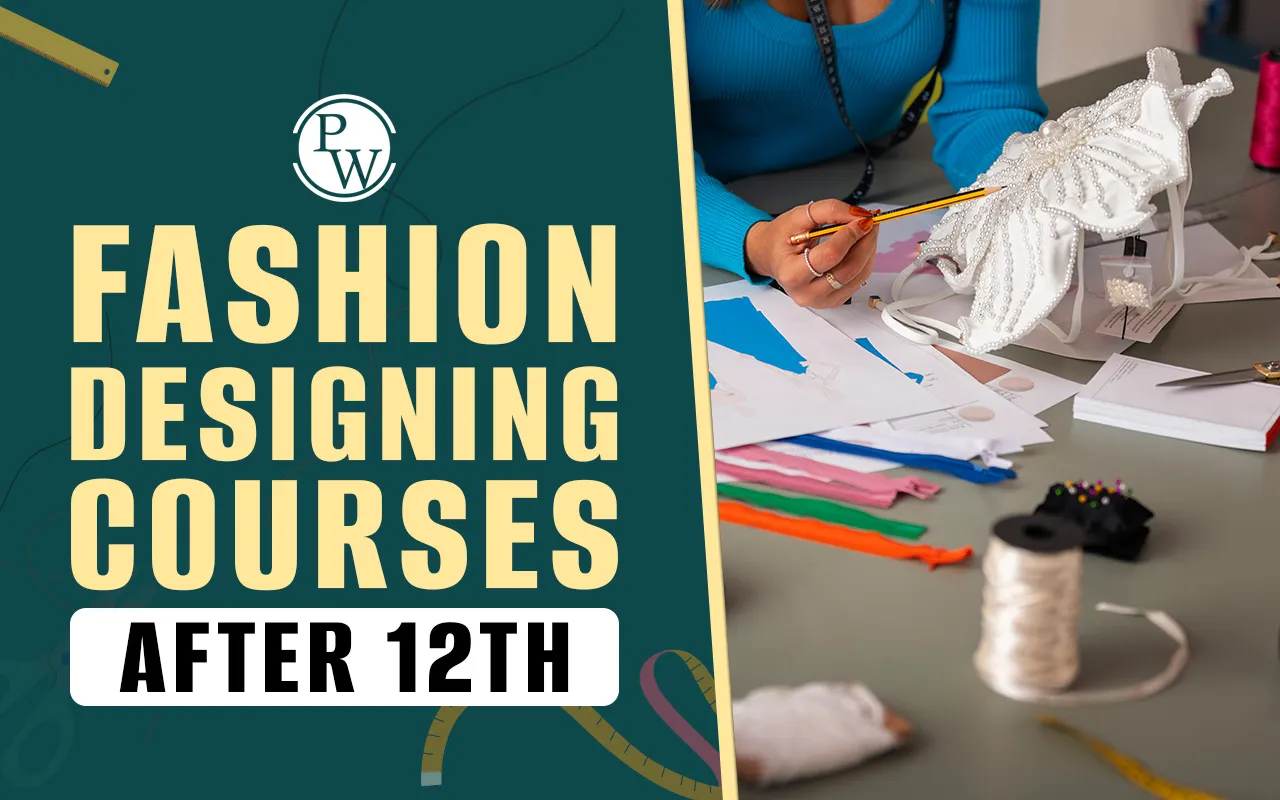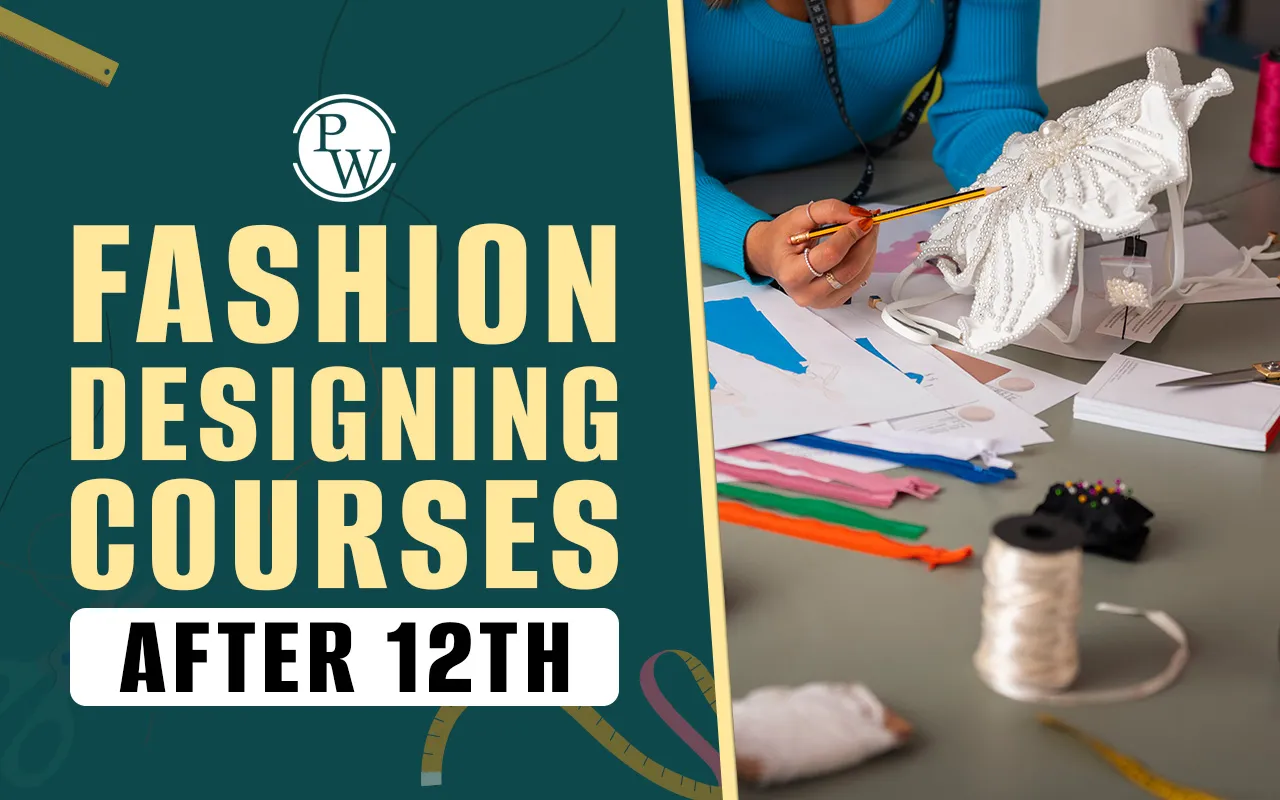

Fashion designing courses after 12th have become a popular choice among students from all streams such as arts, commerce, and science. The diverse nature of the fashion industry has opened doors to various opportunities thereby attracting a pool of students to choose fashion designing courses after 12th. Fashion Designing Courses include undergraduate degrees like B.Des and BA in Fashion Design, as well as diplomas and certificate programs, with top institutes such as NIFT, Pearl Academy, and Symbiosis offering specialized training. The field is highly sought after today due to the booming fashion industry, the rise of global trends, and the increasing demand for innovation and personal expression in clothing and lifestyle.
What is Fashion Designing?
Fashion Designing is the art of creating clothing, accessories, and lifestyle products that are both aesthetically appealing and functional. It blends creativity with technical skills to design styles that reflect trends, culture, and individuality. Aspiring designers must develop a strong sense of color, fabric, and form, along with drawing and visualization skills. To prepare, candidates should build a portfolio, stay updated with fashion trends, and practice sketching and material handling. Enrolling in a good design course and preparing for entrance exams like NIFT, NID, or UCEED can also open doors to top institutes and career opportunities.
Fashion Designing Courses After 12th
The changing landscape of the design industry has motivated many aspirants to pursue designing courses after completing their 12th class instead of choosing the conventional fields of engineering and medicine. Over the last decade, many designing institutes have emerged and have become prominent choices for students. These programs are offered at undergraduate, diploma, and certificate levels, with top options including B.Des in Fashion Design, Bachelor of Fashion Technology, BSc in Fashion Design, and BA in Fashion Design. The duration of these courses ranges from 3 to 4 years for degree programs and 1 to 2 years for diplomas. Get a glimpse of some of these courses in the following table.
BDes in Fashion Designing After 12th
BDes in Fashion Designing is a four-year undergraduate program designed for students aspiring to build a career in the fashion industry. The course covers subjects like garment construction, textile studies, fashion illustration, pattern making, draping, fashion history, and the use of modern design technology. Students gain exposure to the latest trends, sustainability, and global industry practices through workshops, internships, and collaborative projects. The course prepares graduates for diverse roles in fashion design, merchandising, styling, and entrepreneurship in the ever-evolving fashion sector.
Bachelor in Fashion Technology
A Bachelor in Fashion Technology is a specialized undergraduate program that combines the creative aspects of fashion design with the technical expertise required for modern apparel production. This course covers areas such as garment manufacturing, textile science, computer-aided design (CAD), fashion merchandising, and quality control. The program is ideal for those who want to blend creativity with technical skills for a dynamic career in the fashion and apparel sector.
BSc in Fashion Designing
BSc in Fashion Designing is a three-year undergraduate degree program that equips students with comprehensive knowledge of fashion design, including garment construction, textile science, fashion illustration, and merchandising. The course covers various aspects of designing such as sketching, draping, pattern making, and computer-aided design (CAD). Students learn about global fashion trends, fabric technology, and fashion marketing through Bsc in fashion designing. Graduates can pursue careers in fashion design, styling, production, and retail management.
BA in Fashion Designing After 12th
A three-year BA in Fashion Designing after 12th is an UG undergraduate program that delves into the fundamentals of design, fabric selection, and fashion illustration, while also exploring the cultural and historical influences on style. Students benefit from hands-on projects, fashion shows, and industry exposure, equipping them with both creative flair and practical skills. This degree opens doors to dynamic careers in design studios, fashion houses, and the global apparel industry.
BBA Fashion Design & Management
A BBA in Fashion Design & Management is a three-year UG program that blends creative design principles with essential business and management skills. This course covers areas like fashion merchandising, brand management, retail operations, and entrepreneurship alongside core design fundamentals. Graduates are well-equipped for diverse roles, from fashion marketing and retail management to launching their own fashion labels.
Diploma In Fashion Designing
Apart from regular UG design courses, many students, after completing their 12th class, often select diploma courses in fashion designing. These courses are short-term, skill-focused programs that provide foundational knowledge and practical training in fashion design, garment construction, textile selection, and fashion illustration. Diploma courses in designing extend to about 1-2 years and are ideal for students who want to quickly enter the fashion industry or enhance their creative abilities without committing to a full degree. Many designing institutes offer flexible learning modes, including regular, part-time, and online options, making it accessible to a wide range of learners.
Online Fashion Designing Course
Online fashion designing courses offer flexible, accessible learning opportunities for aspiring designers to develop skills in sketching, fabric selection, garment construction, and fashion illustration from anywhere. These courses cover essential design principles, trend analysis, and digital tools like Adobe Illustrator and Photoshop, enabling students to create professional portfolios.
- AAFT Online offers a 1-year online diploma course in fashion design. It covers topics like pattern making, garment construction, textile design, and entrepreneurship. The course fee is approximately Rs 1.50 lakhs.
- JD Institute of Fashion Technology also offers a 2-week online certificate course in Digital fashion illustrations. It teaches technical illustration skills and application innovations of Corel Draw. The course fee is Rs 2999.
Admission to Fashion Design Courses After 12th
For admission to fashion design courses candidates need to have completed their 10+2 from a recognized board with minimum aggregate marks as prescribed by the authorities. Some institutes take admission based on the performance in the entrance exams such as NIFT, NID DAT, and UCEED, while some colleges offer merit-based or direct admissions for diploma and certificate programs. It’s important to carefully check each college’s specific eligibility criteria and admission process before applying.
Fashion Designing Entrance Exams 2025
Common Fashion Design Entrance exams include NIFT, NID DAT, UCEED, and Pearl Academy Entrance Test. These exams include written tests, situation tests, and personal interviews or portfolio reviews. Candidates aspiring for admission to reputed fashion design institutions should stay updated on exam dates, eligibility criteria, and preparation strategies to ensure a successful application process. Following are the major entrance exams with their conducting body.
Fashion Design Colleges 2025
Fashion Design Colleges in 2025 offer a wide range of undergraduate programs for students aspiring to enter the dynamic world of fashion after 12th. Top institutes like NIFT Delhi, NIFT Mumbai, and Pearl Academy, are renowned for their quality education, industry exposure, and strong placement records. Admission to these colleges is highly competitive, often requiring candidates to clear entrance exams such as the NIFT Entrance Exam or the Pearl Academy Entrance Test. Check out the fashion designing colleges in the following table along with their total fee structure.
Career in Fashion Designing
With opportunities in design studios, fashion houses, retail brands, and entrepreneurship, this field blends innovation with business acumen. As the global fashion industry continues to grow, skilled fashion designers are in high demand for their ability to anticipate and set new style directions. Some of the sights after careers are mentioned below.
Fashion Designing Courses After 12th FAQs
What are the eligibility criteria for Fashion Design courses in 2025?
Admission eligibility varies by program level. For undergraduate courses, candidates must have completed Class 12 from a recognized board, with specific subject requirements at some institutions.
How can I apply for Fashion Design courses through entrance exams?
To apply for Fashion Design courses through entrance exams, candidates must register on the official website, fill out the application form, and submit required documents along with the exam fee before the deadline.
Which are the top colleges offering Fashion Design courses in India?
Leading institutions offering Fashion Design courses include National Institute of Fashion Technology (NIFT), National Institute of Design (NID), Pearl Academy, among others.
What are some popular entrance exams for Fashion Designing in 2025?
Entrance exams such as NIFT Entrance Exam, NID DAT, UCEED, CEED, and Pearl Academy Entrance Exam are widely recognized for admissions to Fashion Design courses. Each exam has its schedule, pattern, and syllabus, so candidates should stay updated through official notifications.
Is Fashion Design a good career?
Yes, fashion design can be a rewarding career, offering diverse opportunities in design, styling, and merchandising. The industry is dynamic and evolving, with new opportunities emerging in digital fashion, sustainable design, and e-commerce.













